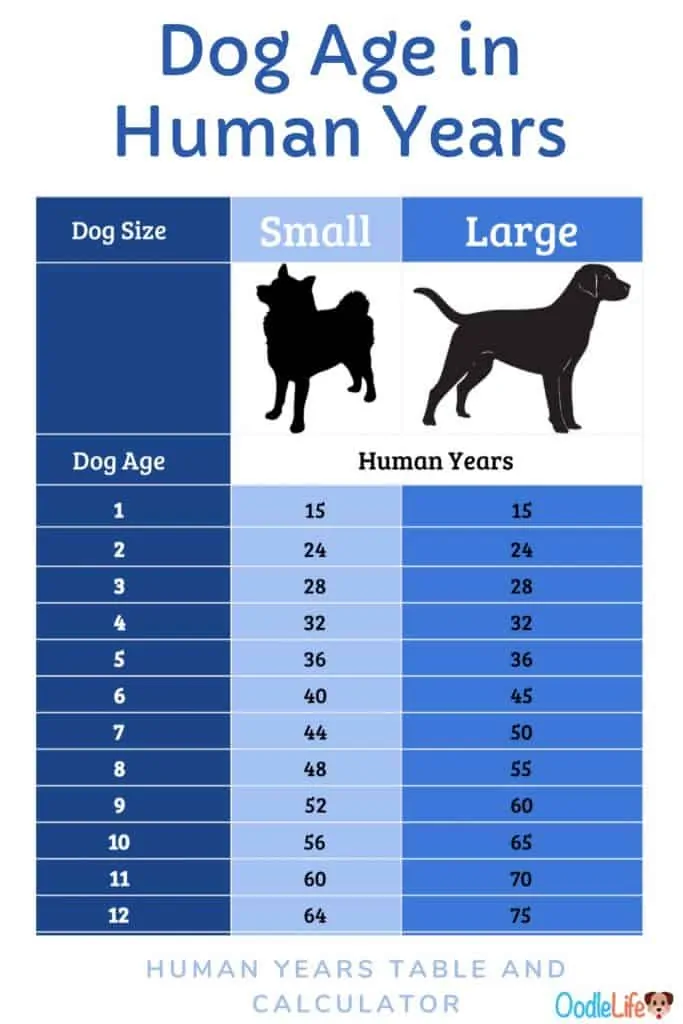Calculator: Dog Years For Small Dogs? Conversion Table and Best Dog to Human Age Formula
Did you know that there are different dog years for different size dogs?
The old school rule converting dog years to human years is pretty simple. You would simply multiply the dog’s age by seven. So the old rule meant a two-year-old dog would be considered to be 14 in human years. Dog years for small dogs are different.

The trouble is the rule just does not take into account different sized dogs. So no, a dog year is not the same as 7 years for humans, especially for small dogs.
Smaller dogs live much longer than large dogs. This means that the 7-year rule just doesn’t work for small dogs.
Luckily there is a better formula that works well to convert small dog years to human years.
In the following article, we share the details of small dogs to human years research, a puppy-to-human-year calculator, and additional information about dog years for small dogs.
OodleLife Veterinarian Dr Alice Adams
Why is the 7 Year Rule Bogus?
The 7-year rule is not accurate or correct for all dogs (especially small dogs) because dogs age more quickly than humans when they are puppies.
The first two years of a dog’s life are full of rapid growth and maturation. Physically and mentally, dogs mature very rapidly at this time. A 2-year-old dog can be fully grown and mature. A human is not done growing by age 14!
Small dog breeds actually reach full size and maturity even more quickly than the two-year mark. While it might take the two years for a large breed like the Bernedoodle to completely fill out, a miniature Cockapoo or Cavapoo can reach full height by 12 months and be virtually fully grown by 18 months.
The aging actually slows down towards the end of life, which means that again it is difficult to precisely compare the age of a dog to human years.
Luckily there is a small dog year to human year table and our calculator, which can tell you how old your dog is in human years.

The Formula for Small Dog Age in Human Years
Scientists studied the genetics of 104 Labrador Retrievers (one parent breed of the amazing Labradoodle) to see how their cells aged. This was some next level scientific research! They could monitor the rapid early growth in the first two years and the slowed growth over time.
They came up with a formula that calculates the actual age in human years of a dog to match this genetic data! The method can be done by hand (you will soon see why you might skip this), or use our dog age calculator instead.
The scientific formula they developed to calculate the actual age in human years of a dog is to multiply the natural logarithm of a dog’s age by sixteen, then add thirty-one.
HUMAN AGE = 16 x LOG(DOG AGE) + 31
Simple right? Well, not easy to do in your head, that is for sure! Luckily we made a dog age calculator that allows you to see your dog’s age in human years using this formula.
Dog Years For Small Dogs Calculator
Input the current age of your small dog into the calculator, and we run the scientific formula to see what age the research says your small dog is in human years.
Table Showing Dog Ages in Human Years
Small dogs and large dogs age differently in human years.
This table and infographic show the difference in growth rates and relative human ages for a small dog (< 12 kilograms/26 pounds) and a large dog (12+ kilograms/26+ pounds).
| Size of Dog | Small Dog (<12 kilograms 26 pounds] | Larger Dogs (>12 kilograms >26 pounds) |
|---|---|---|
| Age of Dog | Age of Dog in Human Years | |
| 1 | 15 | 15 |
| 2 | 24 | 24 |
| 3 | 28 | 28 |
| 4 | 32 | 32 |
| 5 | 36 | 36 |
| 6 | 40 | 45 |
| 7 | 44 | 50 |
| 8 | 48 | 55 |
| 9 | 52 | 60 |
| 10 | 56 | 65 |
| 11 | 60 | 70 |
| 12 | 64 | 75 |
| 13 | 68 | 80 |
| 14 | 72 | 85 |
| 15 | 76 | 90 |
| 16 | 80 | 95 |
As you can see, the small dog ages more slowly in later life than the larger dog. This is because smaller dogs tend to live longer! In fact, the size of a dog is one of the most significant variables that will influence how long your dog will live.
The table results will be slightly different than the formula as it is simplified. The overall results will be around the same.
Why Do Small Dogs Live Longer?
A constant message when researching dogs years for small dogs is the fact that small dogs live for longer. Research shows that small dogs live up to 50% longer than larger breeds.
Some small dogs like Teacup Goldendoodles, Cockapoos, or Chihuahuas have lived up to twenty years! These cases are outliers but still amazing to think about.
Larger dog breeds like Saint Bernards, Bernedoodles, or Great Danes will have shorter life expectancies.
Reasons that small dogs live longer include:
- For many species, size and lifespan are inversely related. This means that the larger the animal, the shorter the average lifespan.
- The rapid growth that larger dog breeds achieve increases the risk of cells causing cancer as they rapidly multiply.
- Larger dogs can also have more environmental risks as they are more often outdoor active dogs or working dogs. Some larger dogs also live outside.
- The genetics make them age more quickly, they get tired and pass on because they are comparatively much older physically even if the same number of years have passed.
Resources
- Scientists study Labrador retrievers to determine the ageing formula for dogs (Science Alert)
- Why do small dogs live longer? (phys.org)